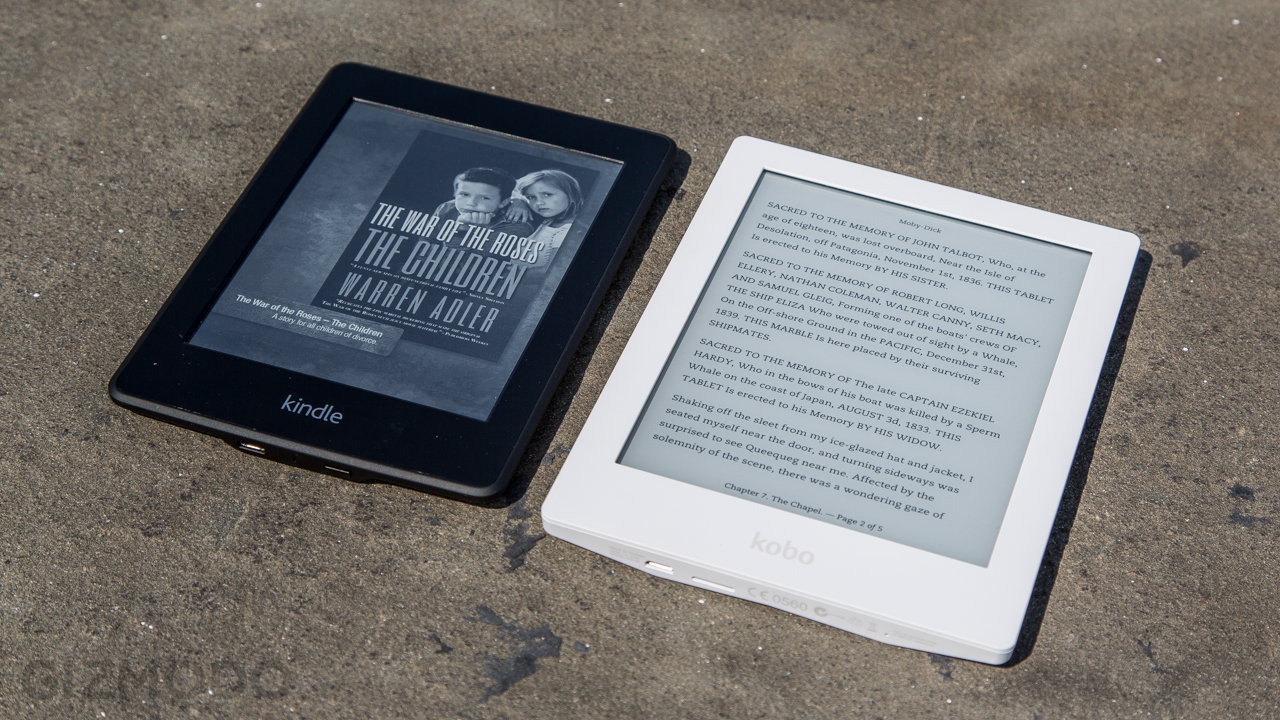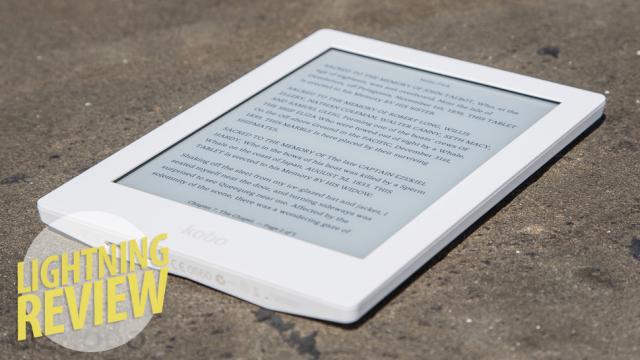Everyone loves a pretty screen. The Kobo Aura HD is aiming to lead that charge in the ereader space. Armed with a best-in-class screen and an unusually powerful processor under the hood, the Aura HD tries its best to be a real luxury reader. It doesn’t quite make it.
What Is It?
A front-lit ebook reader with a big, high-resolution screen.
Who’s It For?
Readers who really, really want a pretty screen and more power than usual under the hood.
Design
The Kobo Aura HD’s body is smooth plastic, unlike the Kindle Paperwhite’s black soft-touch coating. It has two buttons at the top, one to wake the device, the other to toggle the front-light. The Aura HD is stark and simple from the front, but its back is contorted into a strange, asymmetric design intended to invoke crumpled paper or something like it. This back is awkward to look at and to hold. It’s got a very distinctive look, but it sacrifices any semblance of comfort. And since the Aura HD is using infrared touch tech instead of the capacitive found in the Kindle Paperwhite, it’s got more bulk than you’d expect in a brand new ereader.

Using It
The Aura HD has that 6.8-inch 1080×144, 265 DPI screen, and it really is world class. With the backlight off, it feels like you could be looking at ink on paper, and to the extent you might scrutinise the edges of the letters in the words in your ebook, that’s nice. But it’s not a massive step ahead of the fidelity of the Kindle Paperwhite or Kobo Glo, really. The extra screen space doesn’t really add enough real estate to make much of a difference — especially not at the cost of a larger body.
Physically, the Aura is just slightly too wide to be comfortable for one-handed use. Palming it requires a bit of straining, and if you opt to hold it by the corner, its weight will get the better of you. This is compounded by the odd angles on the side of the Aura HD, which make holding it by the very edge slipperier than it ought to be. The Aura also has a 1GHz processor, but you’d be hard-pressed to really notice; the infrared screen effectively throttles max speed, so it’s hard to differentiate. There’s cloud-syncing built in if you read books across devices (in a Kobo app on a phone, for instance) and the reader’s achievement system is cute, if superfluous. Kobo’s software has been problematic in the past, and it still has its annoying quirks. Brightness, font-size and other options are all controlled by finicky draggable bars when they’d be better suited software buttons, since it’s still using IR touch tech.

The Best Part
The screen. It’s wonderful. Large and beautiful and bright. Oh, it’s very bright. While it might not be a humongous improvement over other high quality E Ink screens out there, it’s a wonderful thing to look at.
Tragic Flaw
Everything but the screen. Compared to its contemporaries, the Aura HD is large, heavy, and awkward. For every second you find yourself thinking “this screen is nice!” there will be five where you think “I wish I wasn’t holding this!”
This Is Weird…
The back of the Aura is just bizarrely designed. If you set the Aura HD on its back on a flat surface and poke the corner, it wobbles slightly. It’s ugly and uncomfortable to hold and it makes you wonder if the back’s shape was decided at random.
Test Notes
- At its max, the Aura’s backlight is stronger than the Paperwhite’s, and more even around the edges. The downside is that it tends to bleed through the text at higher levels, and the contrast suffers.
- Kobo rates the Aura HD’s batter as lasting two months — backlight on or off — with 30 minutes of reading a day. Over about half a week of heavier use (45-60 minutes, backlight on, brightness at 50 per cent) we took it down to about 70 per cent.
- The Kobo store has about 2.5 million books, newspapers, and magazines, coming out just slightly on top of Amazon’s two million Kindle store results. You’ll have no trouble finding bestsellers at either store, though Amazon’s prices are occasionally a few dollars cheaper than Kobo’s offerings. And Kobo has no lending system in place, unlike both Amazon and Barnes and Noble, so expect to pay for everything you want to read.

Should You Buy It?
No. The Kobo Aura HD has a really nice screen, sure, but everything around that screen just drags it down. From the ergonomically bizarre design to its weight and size, the actual meat of the Aura HD is just not up to snuff. And besides that, pushing an E Ink screen’s resolution this high is sort of a questionable pursuit here. You don’t need that extra resolution to read, and it’s reached a point of diminishing returns. That screen’s not nice enough to cancel out other basic problems with the design. Props to Kobo for being the best at something, but the compromises born of that tunnel vision aspiration are just too high. At $220 RRP in Australia the Kobo Aura HD is too expensive for something that does the wrong things right and the right things wrong.
Kobo Aura HD
• Display: 6.8 inches, 265 dpi, 1440 x 1080 resolution
• Dimensions: 175.7mm x 128.3mm x 11.7mm
• Weight: 240g
• Storage: 4GB, microSD expansion slot
• Connectivity: Wi-Fi only
• Colour: “Espresso, Ivory or Onyx”
• Supported file types: EPUB, PDF, and MOBI, CBR, CBZ
• Price: $220 RRP in Australia, available in stores and online in June 2013
